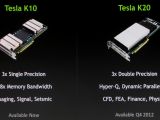
Nvidia is not all defenseless before Intel’s money, market influence, software development, process manufacturing superiority and the general success of the Xeon Phi.
Be sure to check out the first, second and third parts of our GPU compute analysis.
We’re sure there’s a great deal of marketing and PR talk in Intel’s claim that porting applications to Xeon Phi is only a “matter of days,” instead of weeks or months.
Nvidia has two main strong points now.
The first one is the fact that their upcoming GK110 GPU that will power the Tesla K20 card is set to bring more than three times the DP FP64 performance of Nvidia’s previous Tesla generation powered by the Fermi architecture.
We know that the Tesla M2090 Fermi-based GPU compute accelerator card is able to process a strong 0.66 TFLOPs of DP FP64 operations, and if the new K20 will be rated at over 1.9 TFLOPs, Intel’s Xeon Phi doesn’t look so powerful anymore.
 |
Supercomputing clients usually have very complex projects to run on their mega servers, and if one technology can deliver the result in one month, while the other will deliver it in twice the time, we have a hard time believing that the client will choose the slower hardware.
The second strong point the Kepler-CUDA-GK110 combination gives Nvidia is exactly the continuity of the platform itself, and the fact that CUDA porting could be actually already done before GK110 reaches the client.
More on Nvidia’s strong points and ways to counteract the Xeon Phi in the fifth part of our GPU computing analysis.
Via: Xeon-Phi and AMDs GCN Squeezing Nvidias TESLA Part 4
Tidak ada komentar:
Posting Komentar